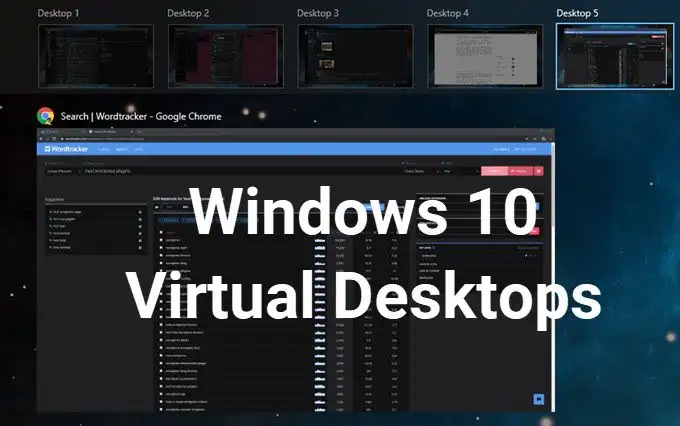
In the ever-evolving landscape of digital technology, Windows 10 stands out as a versatile and user-centric operating system, continually introducing features that redefine the user experience. Among these features, Windows 10 Virtual Desktops emerges as a powerful tool, transforming the way users organize and navigate their digital workspace. This comprehensive guide explores the intricacies of Windows 10 Virtual Desktops, shedding light on its functionality, customization options, and how it optimizes productivity for users in the digital age.
Understanding Windows 10 Virtual Desktops
Windows 10 Virtual Desktops represent a paradigm shift in how users interact with their digital environment. This feature allows users to create multiple, independent desktops within a single Windows 10 system, each tailored to specific tasks or projects. By seamlessly switching between these virtual desktops, users can declutter their workspace, enhance organization, and streamline their workflow.
- Accessing Virtual Desktops: The Gateway to Multitasking Mastery
To access Virtual Desktops in Windows 10, users can utilize the Task View button on the taskbar or employ the keyboard shortcut Windows key + Tab. This opens a visually intuitive interface where users can view, manage, and create new virtual desktops. The Task View also provides a quick overview of open windows across all desktops, simplifying multitasking.
- Creating and Managing Virtual Desktops: Tailoring Your Digital Space
Windows 10 empowers users to create and manage virtual desktops with ease. By clicking the “+ New Desktop” button in the Task View or using the keyboard shortcut Windows key + Ctrl + D, users can establish additional desktops. The Task View interface enables efficient management, allowing users to switch between, close, or rearrange virtual desktops effortlessly.
- Customizing Virtual Desktops: A Personalized Digital Canvas
Customization is at the core of Windows 10 Virtual Desktops. Users can personalize each desktop by dragging and dropping specific windows onto the desired desktop, setting distinct wallpapers, and arranging applications according to their preferences. This level of customization tailors the digital workspace to individual needs, fostering a more comfortable and efficient working environment.
Navigating the Virtual Landscape: Practical Tips and Techniques
- Keyboard Shortcuts for Virtual Desktop Mastery
Windows 10 provides a set of keyboard shortcuts that enhance the efficiency of managing virtual desktops. Learning these shortcuts, such as Windows key + Ctrl + Left/Right arrow to switch between desktops or Windows key + Ctrl + F4 to close the current desktop, can significantly speed up navigation and multitasking.
- Taskbar Integration: Quick Access to Virtual Desktops
The Windows 10 Taskbar seamlessly integrates with Virtual Desktops, offering a quick and accessible way to navigate between desktops. Users can use the Taskbar to switch directly to a specific application or window on a different virtual desktop, minimizing interruptions and enhancing task-focused navigation.
- Snap Assist: Enhancing Window Organization Across Desktops
Snap Assist in Windows 10 extends its functionality to virtual desktops, enabling users to snap windows into organized layouts. By dragging a window to the edge of the screen, users can leverage Snap Assist to neatly arrange and optimize the distribution of applications across multiple virtual desktops.
- Dynamic Window Switching: Streamlining Workflow Transitions
Windows 10 introduces dynamic window switching, allowing users to move applications seamlessly between virtual desktops. By pressing and holding the Windows key and then using the arrow keys, users can transfer windows between desktops with intuitive precision, enhancing fluid transitions within their digital workspace.
Advanced Techniques for Virtual Desktop Mastery
- Task View Timeline: Time-Traveling Through Productivity
Task View in Windows 10 offers a timeline feature that extends to virtual desktops. This feature provides a chronological view of recent activities and opened applications across all desktops, allowing users to revisit and restore specific states of their digital workspace, even after switching between virtual desktops.
- Using Virtual Desktops for Specific Tasks: Project-Centric Efficiency
To maximize productivity, users can designate virtual desktops for specific tasks or projects. For instance, one desktop may be dedicated to work-related applications, while another focuses on creative endeavors or entertainment. This project-centric organization optimizes efficiency and minimizes distractions.
- Dynamic Desktop Switching with Hotkeys: Streamlined Navigation
Power users can leverage third-party tools or scripts to set up hotkeys for dynamic virtual desktop switching. This advanced technique enables users to switch between desktops seamlessly without entering the Task View, enhancing speed and fluidity in navigating the digital workspace.
- Remote Desktops and Virtual Machines: Extending the Virtual Horizon
Windows 10 Virtual Desktops can also be utilized in conjunction with remote desktop connections or virtual machines. This advanced application allows users to access and manage different operating systems or remote environments within separate virtual desktops, providing unparalleled versatility in digital workspace management.
- Automating Virtual Desktop Workflows: Scripting for Efficiency
Advanced users can explore scripting and automation techniques to further enhance virtual desktop workflows. By utilizing PowerShell or third-party automation tools, users can create custom scripts for tasks such as automatically launching specific applications on designated desktops, streamlining repetitive actions in their digital workspace.
Future Considerations and Technological Advances
As Windows 10 evolves, Microsoft continues to refine and expand the capabilities of Virtual Desktops. Users can anticipate ongoing improvements, new features, and enhanced integration with emerging technologies. Staying informed about updates and exploring evolving functionalities will empower users to continually optimize their virtual desktop workflows in line with the latest advancements.
Conclusion
Windows 10 Virtual Desktops redefine the landscape of digital productivity, offering users a dynamic and customizable workspace that adapts to their individual needs. By understanding the basics, incorporating practical tips and techniques, and exploring advanced methods, users can unlock the full potential of Windows 10 Virtual Desktops. Whether aiming for multitasking mastery, project-centric efficiency, or seamless navigation, the advanced features of Windows 10 Virtual Desktops provide a powerful toolkit for optimizing productivity and enhancing the digital work environment in the modern era.